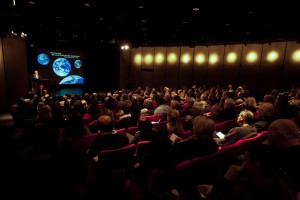 This past January not only marked the start of a new year and decade, but the beginning of a new visioning process for the College as well. Two back-to-back events—an evening panel discussion featuring national thought leaders, and a daylong brainstorming session tackling key issues relating to Art Center’s mission statement—were open to the Art Center community.
This past January not only marked the start of a new year and decade, but the beginning of a new visioning process for the College as well. Two back-to-back events—an evening panel discussion featuring national thought leaders, and a daylong brainstorming session tackling key issues relating to Art Center’s mission statement—were open to the Art Center community.
On January 13, faculty, staff, students, alumni, trustees and friends packed the Ahmanson Auditorium for the visioning kickoff. The evening session—Twittered and webcast live—featured a distinguished panel of speakers: Andrew Blauvelt, design director and curator at the Walker Art Center; Katherine Hayles, professor and director of graduate studies in literature at Duke University; Steven Oliver, board member of the grant-making organization United States Artists; and David Rice, chairman and founder of The Organization of Black Designers.
Before introducing the panelists, Art Center President Lorne Buchman stressed the imperative of higher education to value driven learning and thinking. “The capacity of our students and graduates to affect change is enormous,” he said. “We need to be educating responsible citizens—the question is how to do that.”

 Another childhood dream of ours is about to become a reality: Virgin has unveiled an underwater plane that will fly into the depths of the Caribbean Sea.
Another childhood dream of ours is about to become a reality: Virgin has unveiled an underwater plane that will fly into the depths of the Caribbean Sea. A group of New York City government agencies have teamed with the AIA to create the
A group of New York City government agencies have teamed with the AIA to create the  The
The  a “cross between a Baja racer and a P-51 Mustang fighter plane”— was created by
a “cross between a Baja racer and a P-51 Mustang fighter plane”— was created by  We’ve always known it, but now it’s official: Art Center’s
We’ve always known it, but now it’s official: Art Center’s  USC professor Adlai Wertman, the event will feature Mariana Amatullo, vice president and director of Designmatters; Jonathan Greenblatt, social entrepreneur and founder of All for Good and Ethos Water; and Rhys Newman, head of design strategic projects at Nokia Design and former Art Center faculty member.
USC professor Adlai Wertman, the event will feature Mariana Amatullo, vice president and director of Designmatters; Jonathan Greenblatt, social entrepreneur and founder of All for Good and Ethos Water; and Rhys Newman, head of design strategic projects at Nokia Design and former Art Center faculty member. has launched a global call to designers from all disciplines to unite in an open dialogue with international relief organizations to assess potential design-effective rehabilitation projects.
has launched a global call to designers from all disciplines to unite in an open dialogue with international relief organizations to assess potential design-effective rehabilitation projects. Perhaps this is why museum guards say not to get too close to the work: A significant
Perhaps this is why museum guards say not to get too close to the work: A significant  Our own Stephen Nowlin, director and curator of the
Our own Stephen Nowlin, director and curator of the